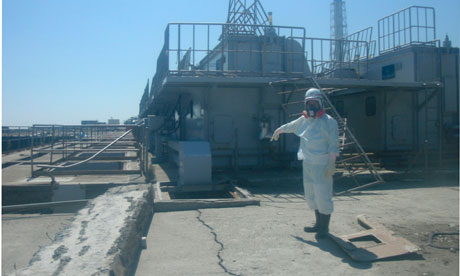Tepco officials say 20cm crack in containment pit under reactor two may be source

Radioactive water from Japan's quake-striken Fukushima Daiichi nuclear plant is leaking into the sea, its operator said.
The 20cm (8in) crack in a containment pit under reactor two may be the source of recent radiation in coastal waters, Tokyo Electric Power (Tepco) officials said.
Hidehiko Nishiyama, deputy director-general of the Nuclear and Industrial Safety Agency, said Tepco was planning to pour concrete into the pit to seal the crack, which may have been leaking since the magnitude 9.0 earthquake three weeks ago.
"This could be one of the sources of seawater contamination," Nishiyama said. "There could be other similar cracks in the area, and we must find them as quickly as possible."
Readings released on Saturday showed radiation in seawater had spread to 25 miles (40km) south of the plant. The concentration of iodine there was twice the legal limit, but officials stressed it was still well below levels that are dangerous to human health.
The announcement of the radioactive leak came as Japan's prime minister Naoto Kan surveyed the damage in the town of Rikuzentakata, which was gutted by the devastating tsunami that hit the country following the quake.
The prime minister bowed his head for a minute of silence in front of the town hall, one of the few buildings still standing, which has all its windows blown out and debris piled up in front of it.
"The government fully supports you until the end," Kan later told 250 people at an elementary school that is serving as an evacuation centre.
He met with the town's mayor, Megumi Shimanuki, whose 38-year-old wife was swept away in the wave and is still missing. Shimanuki, whose family is living in a similar shelter 100 miles (160km) away in Natori, said Kan did not spend enough time with people on the ground.
"The government has been too focused on the Fukushima power plant rather than the tsunami victims," said Shimanuki, 35. "Both deserve attention."
One member of the power plant crew described difficult conditions inside the complex in an interview in the Mainichi newspaper. He said the plant has run out of the nylon protective booties that workers put over their shoes.
"We only put something like plastic garbage bags you can buy at a convenience store and sealed them with masking tape," said the anonymous worker.
He added that the grounds of the power plant were littered with dead fish churned up by the tsunami.
Japanese media reported that nuclear workers had been offered up to 400,000 yen (£3,000) a day to work inside the crippled reactors. Before the crisis some contract workers were reportedly being paid as little as 10,000 to 20,000 yen (£75 to £150) a day.
Three weeks after the tsunami more than 165,000 people are living in shelters, while 260,000 households still do not have running water and 170,000 do not have electricity.
No comments:
Post a Comment